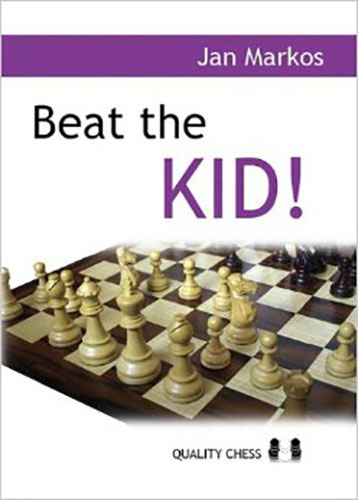- Winkel
- >
- Schaken
- >
- Schaakboeken
- >
- Openingen
- >
- Koningsindisch 1.d4-Nf6 2.c4-g6
- >
- Beat The KID
Beat The KID
SKU:
€23.99
€23.99
Unavailable
per item
- Markos J.
- Quality Chess
- 197 blz.
- Engels
The King's Indian Defence is one of Black's most ambitious and popular replies to 1.d4 so White needs to be well prepared. Jan Markos shows the way with three separate repertoires for White.
The Bayonet Attack : 1.d4 Nf6 2.c4 g6 3.Nc3 Bg7 4.e4 d6 5.Nf3 0-0 6.Be2 e5 7.0-0 Nc6 8.d5 Ne7 9.b4 This line is favoured by the elite and is regarded as the critical test of the King's Indian. Korchnoi has added more to the biggest main line in the King's Indian than any other player, thus the line should be named after him: 1.d4 Nf6 2.c4 g6 3.Nc3 Bg7 4.e4 d6 5.Nf3 0-0 6.Be2 e5 7.0-0 Nc6 8.d5 Ne7 9.Ne1 This line leads to wild complications and mutual attacks where the betterprepared player has a huge advantage. Krasenkow has an overwhelming score with his pet line: 1.d4 Nf6 2.c4 g6 3.Nc3 Bg7 4.e4 d6 5.Nf3 0-0 6.h3 This is a strategic line where understanding is needed rather than memorization.
Jan Markos is a young grandmaster from Slovakia who has won many international tournaments.
Content:
006 Key to symbols used & Biblography
007 Foreword - what can be found in this book
009 Introduction to the King's Indian Defence
015PART 1 - The Krasenkow Variation
017 Introduction - The Art of Prophylaxis
021 1 The Modern Benoni Structure
027 2 Avoiding the Pin - 7...Nh5
033 3 Black Plays 7...h6
039 4 Black does not Play 7...h6 and Plays ...Na6 with his Pawn on a7
047 5 Black does not Play 7...h6 and Plays ...Na6 with his Pawn on a5
055 Conclusion to part
057PART 2 - The Bayonet Variation 059 Introduction - An Open Fight
061 6 Black's Rare Answers and Introduction to the 9.b4 a5 Line
071 7 9...a5 10.Ba3 axb4 11 Bxb4 b6
079 8 9...a5 10.Ba3 axb4 11.Bxb4 Nd7
085 9 9...Nh5 10.Re1 a5
093 10 9...Nh5 10.Re1 f5 11.Ng5 Nf4
097 11 Introduction to the 9...Nh5 10.Re1 f5 11.Ng5 Nf6 System and the 12.Bf3 c6 13.Be3 Line
105 12 9...Nh5 10.Re1 f5 11.Ng5 Nf6 12.Bf3 c6 13.Bb2
109 13 9...Nh5 10.Re1 f5 11.Ng5 Nf6 12.f3
121 Conclusion to part 2
123PART 3 - The Classical Variation 125 Introduction - Back to the Roots
129 14 9.Ne1 c5 and 9.Ne1 Nd7/Ne8 10.f3 f5 11.g4
143 15 Introduction to the 9.Ne1 Nd7 10.f3 f5 11.Be3 f4 12.Bf2 g5 13.a4 Line and 13.a4 Rf6
147 16 9.Ne1 Nd7 10.f3 f5 11.Be3 f4 12.Bf2 g5 13.a4 a5
153 17 9.Ne1 Nd7 10.f3 f5 11.Be3 f4 12.Bf2 g5 13.a4 Ng6
167 18 9...Ne8!?
173 Conclusion to part 3
175EPILOGUE - Sixth and Seventh Move Alternatives177 19 Tying Up Loose Ends
192 Index of Annotated Games
193 Index of Variations
The Bayonet Attack : 1.d4 Nf6 2.c4 g6 3.Nc3 Bg7 4.e4 d6 5.Nf3 0-0 6.Be2 e5 7.0-0 Nc6 8.d5 Ne7 9.b4 This line is favoured by the elite and is regarded as the critical test of the King's Indian. Korchnoi has added more to the biggest main line in the King's Indian than any other player, thus the line should be named after him: 1.d4 Nf6 2.c4 g6 3.Nc3 Bg7 4.e4 d6 5.Nf3 0-0 6.Be2 e5 7.0-0 Nc6 8.d5 Ne7 9.Ne1 This line leads to wild complications and mutual attacks where the betterprepared player has a huge advantage. Krasenkow has an overwhelming score with his pet line: 1.d4 Nf6 2.c4 g6 3.Nc3 Bg7 4.e4 d6 5.Nf3 0-0 6.h3 This is a strategic line where understanding is needed rather than memorization.
Jan Markos is a young grandmaster from Slovakia who has won many international tournaments.
Content:
006 Key to symbols used & Biblography
007 Foreword - what can be found in this book
009 Introduction to the King's Indian Defence
015PART 1 - The Krasenkow Variation
017 Introduction - The Art of Prophylaxis
021 1 The Modern Benoni Structure
027 2 Avoiding the Pin - 7...Nh5
033 3 Black Plays 7...h6
039 4 Black does not Play 7...h6 and Plays ...Na6 with his Pawn on a7
047 5 Black does not Play 7...h6 and Plays ...Na6 with his Pawn on a5
055 Conclusion to part
057PART 2 - The Bayonet Variation 059 Introduction - An Open Fight
061 6 Black's Rare Answers and Introduction to the 9.b4 a5 Line
071 7 9...a5 10.Ba3 axb4 11 Bxb4 b6
079 8 9...a5 10.Ba3 axb4 11.Bxb4 Nd7
085 9 9...Nh5 10.Re1 a5
093 10 9...Nh5 10.Re1 f5 11.Ng5 Nf4
097 11 Introduction to the 9...Nh5 10.Re1 f5 11.Ng5 Nf6 System and the 12.Bf3 c6 13.Be3 Line
105 12 9...Nh5 10.Re1 f5 11.Ng5 Nf6 12.Bf3 c6 13.Bb2
109 13 9...Nh5 10.Re1 f5 11.Ng5 Nf6 12.f3
121 Conclusion to part 2
123PART 3 - The Classical Variation 125 Introduction - Back to the Roots
129 14 9.Ne1 c5 and 9.Ne1 Nd7/Ne8 10.f3 f5 11.g4
143 15 Introduction to the 9.Ne1 Nd7 10.f3 f5 11.Be3 f4 12.Bf2 g5 13.a4 Line and 13.a4 Rf6
147 16 9.Ne1 Nd7 10.f3 f5 11.Be3 f4 12.Bf2 g5 13.a4 a5
153 17 9.Ne1 Nd7 10.f3 f5 11.Be3 f4 12.Bf2 g5 13.a4 Ng6
167 18 9...Ne8!?
173 Conclusion to part 3
175EPILOGUE - Sixth and Seventh Move Alternatives177 19 Tying Up Loose Ends
192 Index of Annotated Games
193 Index of Variations
